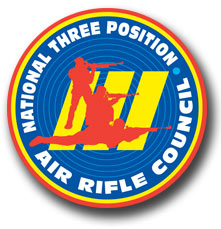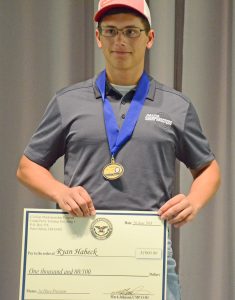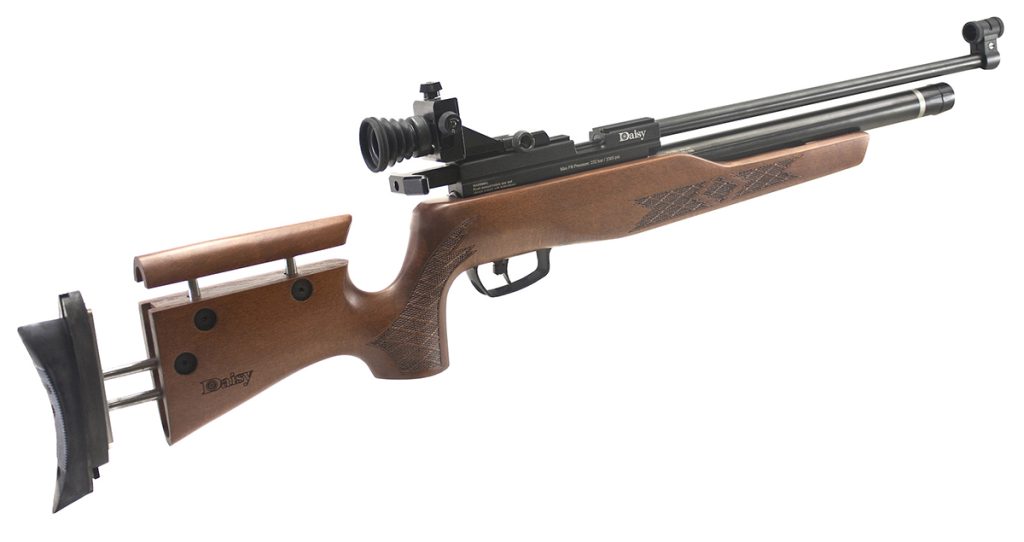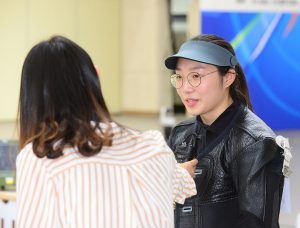2018-2020 Three-Position Air Rifle Rules Released
October 16, 2018
Civilian Marksmanship Program▸The First Shot▸2018-2020 Three-Position Air Rifle Rules ReleasedBy Gary Anderson, DCM Emeritus
Three-Position Air Rifle shooting is the most popular junior rifle program in the USA. Its massive participation base includes more than 2,000 JROTC high school programs, hundreds of 4-H Shooting Sports clubs and several hundred junior rifle clubs. An estimated 250,000 to 300,000 youth participate annually in three-position air rifle programs, with many of them engaging in some form of organized competitive shooting. The main governing body for this major youth sports program is the National Three-Position Air Rifle Council. The Council’s primary means of governing Three-Position Air Rifle events and programs is its rulebook, the National Standard Three-Position Air Rifle Rules.

The National Standard Rules are revised and reissued on a bi-annual basis. The newest version of the Rules, the 12th 2018-2020 edition, has just been released. An electronic version of the new 3-position rules is posted on the CMP website at https://thecmp.org/air/national-standard-three-position-air-rifle-rules/. Printed copies will be available for ordering on November 1st.
The CMP provides staff support for the National Council’s 3-position air rifle programs. Vicki Donoho is the program coordinator and acts as the Council Secretary. She can be contacted at 419-635-2141, ext. 702, or via email at 3PAR@TheCMP.org.
The process of developing rules changes starts with the questions and recommendations received at CMP Headquarters or that are received from participants at 3-position championships. Coaches at the 2018 National Three-Position Championships (Junior Olympic and CMP) were asked for their input on rules. Comments received during this rules cycle focused on fine-tuning existing rules, not on any need for major changes. All comments were evaluated and a new rules draft was prepared and distributed to Council members. This draft was discussed in detail during a 4 October 2018 Conference Call, which concluded with the approval of the 2018-2020 rules.

Here is a summary of the rule changes that are incorporated into the 12th Edition 2018-2020 National Standard Rules. New or changed rules are underlined so they can be more easily identified. Rule numbers of changed rules are listed in the summary to assist in locating them. The previous use of bullet points was changed to letter designations (i.e. a), b), etc.).
- CBIs (Safety Flags), 2.2 & 7.7. A conflict in the previous rules was clarified; CBIs may be removed during Preparation and Sighting, Changeover and Sighting Stages. In Changeover stages, the athlete must be in a standing or kneeling firing position before the CBI can be removed.
- Regular Participation by Team Members, 3.2. Added emphasis was given to the prohibition of all-star teams that “cherry pick” athletes from two or more programs. The 75-mile distance restriction was changed to “a reasonable travel distance.” A guideline that requires a physical presence at least once a month was added.
- One Rifle, One Butt-Plate, One Cheek-Piece and One Set of Sights, 4.1.5, 4.2.4, 4.2.8 & 4.4. Previous rules restricted athletes to one rifle per event, but now the rules clarify that “one rifle per event” also means only one butt-plate, one cheek-piece and one set of sights. A primary objective here is to keep equipment costs from escalating. This new rule applies for both Sporter and Precision events.

- Daisy M599 Sporter, 4.2.1. The new “Daisy M599 Competition Air Rifle” was added to the list of approved Sporter Class rifles.
- Sporter Rifle Barrel Weights, 4.2.2. The allowable maximum radius for Sporter air rifle barrel weights was increased to 40 mm.
- Sporter Cheek-Pieces, 4.2.4 c). The rule was updated to accommodate the use of adjustable cheek-pieces on Sporter air rifles.
- Shorts, 4.3.1 & 4.6. A rule establishing a 15 cm-above-the-knee limit for the length of shorts was included in response to several expressed concerns about whether very short shorts are permitted.
- Precision Butt-Plate Adjustments, 4.4. K. If one-piece butt-plates are used with precision rifles, they may be offset left or right and/or they may be turned on their horizontal and/or vertical axis as long as no part of the butt-plate extends more than 30 mm from a vertical axis through the butt-plate center.
- Fore-End Riser Blocks, 4.4.6. Riser blocks are permitted on precision air rifles, provided no part of the riser block, except for an attachment device or hand stop, extends more than 120 mm below the center-line of the bore (fore-end depth measurement). Fore-end risers must be flat with no curved or anatomical shaping. If they have an external attachment device, it may not be used as a reference point for the hand in standing.
- Shooting Boots, 4.6.4. Boot soles can be cut square (not curved) and must not extend more than 5 mm outside of the curvature of the boot. This is only a clarification, not a rule change.

18-year-old Hana IM from Korea became the Women’s Air World Champion in the 2018 World Shooting Championship. Hana IM started shooting when she was 14 by participating in an air rifle shooting program in her school. - Shooting Gloves, 4.6.6. c). Wearing a sport glove on the trigger hand is permitted in Precision Class, but not in Sporter Class.
- Caps or Visors, 4.7.7. A cap or visor may be worn, but it may not touch the rifle sight and may not extend more than 80 mm from the forehead.
- Prone Position, 5.1.1 i). The right hand (trigger hand) may not touch the left hand, left arm, shooting jacket or sling.
- Athletes with Impairments, 5.1.4 d).The previous rule that provided for a compensating factor for athletes with SH2-impairments was deleted because it was impossible to implement. The new rule asks coaches with athletes who have SH2-type impairments to contact Vicki Donoho at vdonoho@thecmp.org or 419- 635-2141, ext. 702, so an individual participation plan can be worked out.
- Non-Verbal Coaching, 5.2.2. Non-verbal coaching is now permitted, provided it does not disturb other athletes on the firing line.
- Firing Line, 5.5.2. A new definition of the “firing line” was added that explains how this term may refer to the line in front of the firing points or to the entire area that includes the firing points and working area for Range Officers.
- Juries, 6.3 and 9.1. It is clarified that Juries do not have to be appointed unless a protest is filed. In that case, a Jury must be appointed to decide the protest.
- Changeover Stages, 7.7. During Changeover Stages, athletes may set up their equipment for the next position, handle their rifles and get into a standing or kneeling position. After they are in their firing positions, they may remove CBIs and do aiming exercises or dry fire, but they may not load or fire their rifles.
- Music During Competitions, 7.14. Music is still authorized before and after competitions and during finals, but not during qualification competitions. There unfortunately were too many abuses of the rule that allowed music during all phases of the competition. The new rule reads, “Appropriate music may be played prior to firing, immediately following the completion of firing and during finals. Music should not be played during qualification. During other times when music is played, it should be played at a level that permits range commands and instructions to be heard.”
- Misfire. 7.15.10 in the previous rules, which described misfires, was deleted because this situation is covered in 7.17.3. When an athlete claims a “misfire,” the Range Officer must determine whether it was caused by failure to close the bolt properly or by a malfunction.
- Interruptions, 7.16. This rule was simplified. If an interruption is less than 5 min. the time lost is added to the competition time regardless of its length. Interruptions of more than 5 min. still allow for sighting shots plus the addition of lost time. The one-minute threshold for allowing extra time was eliminated.
- Malfunctioning Sights or Equipment, 7.17.1. The new rules clarify that a broken sight or other equipment item may, with Range Officer approval, be replaced.

- Spectators, 7.19. The change clarifies what spectators may and may not do. Spectator conversation and cheering is allowed and encouraged, but shouting instructions to an athlete is illegal coaching (see Rule 5.2). Shouting targeted remarks about a specific competitor may be illegal harassment (see Rule 7.20.5).
- Authorized Electronic Targets, 8.1.2. The KTS 10m targets that are marketed by CMP and manufactured by DISAG were added to the approved target list. Chinese Shooter targets, which were recently approved by the ISSF, were also added.
- Protest and Complaint Procedures for KTS 10m Targets, 8.4.3. KTS targets, which were added to the list of approved electronic targets, do not have paper bands or witness strips, so special rules for protests or complaints were added. The new rule provides that only shots scoring 0-1-2-3 may be protested. If there is a missing shot (failure to register) match officials must decide if there is credible evidence that the athlete cross-fired or shot an off-target miss. Without such evidence, the athlete must be allowed to shoot and count a refire shot.
- Questioned Orion Scores, 8.5.5. This rule was simplified to provide for requests for score re-evaluation to be decided by the Statistical Officer after re-evaluation of the original scanned image. The 2-point penalty for lost protests was deleted.
- EIC Credit Points, Appendix D. The system for awarding EIC credit points for the Junior Distinguished Badge was changed and simplified. Cup Match cut scores were adjusted upwards. The EIC credit points awarded for all national level competitions were changed to a simple 5-4-3 credit point system.
Anyone with questions about any three-position rules should contact Vicki Donoho at vdonoho@thecmp.org or 419- 635-2141, ext. 702. If you have not downloaded your copy of the 2018-2020 rulebook yet, you can do that at https://thecmp.org/air/national-standard-three-position-air-rifle-rules/.